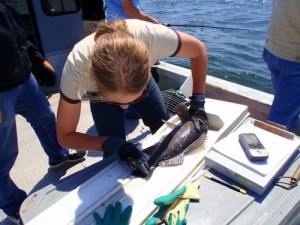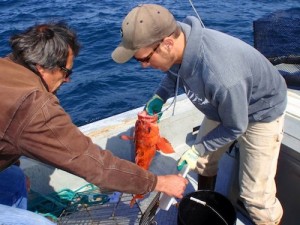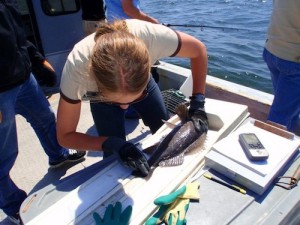Thank you to the 75 volunteer anglers who helped make this year’s hook-and-line surveys a big success! Volunteers play a huge role in collecting important data to monitor reserve effectiveness over time. Check out the end of the season ODFW Volunteer Newsletter to see photos from the season, how many fish and different species were caught and sampled, and who caught the biggest fish.
 ODFW Researcher taking biological measurements of a Black Rockfish
ODFW Researcher taking biological measurements of a Black Rockfish
Download Full Newsletter: 2013_ODFW_Hook-and-Line_end_of_season
Why Do Hook-and-Line Surveys:
Changes in fish size and weight are one of the first early signs of potential marine reserve effects. Hook-and-line surveys are the only way to capture this information with accuracy. By sampling over time, both inside the reserve and outside in fished areas, we can determine whether fish sizes and ages are changing inside the reserve differently than outside due to cessation of harvest.
A variety of sampling methods are used in addition to hook-and-line surveys to collect data on fish, invertebrates, algae, habitats, and oceanographic conditions as part of marine reserves monitoring. Other data collection methods include SCUBA diving, oceanographic instruments mounted to the seafloor, and using high-definition cameras that collect underwater video footage by attaching to a device such as a sled towed along the seafloor or a Remotely Operated Vehicle (ROV) that is flown underwater. Over the next decade, these monitoring efforts will begin to tell us if and what effects the marine reserves (prohibition of extractive activities) have on the marine environment.

Volunteers with ODFW release rockfish as part of marine reserve monitoring


